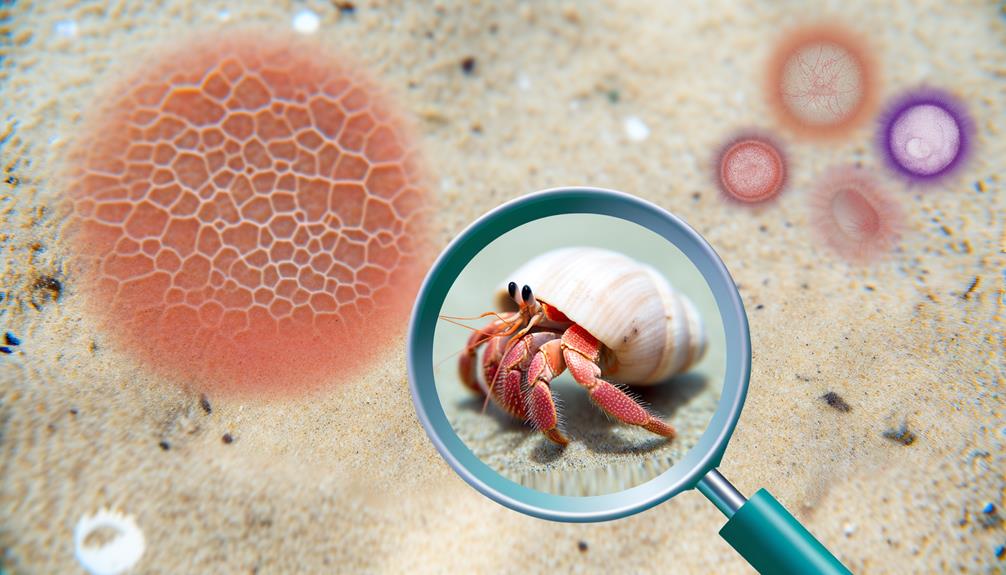Do Hermit Crabs Carry Salmonella?
Hermit crabs can harbor diseases like Salmonella, which pose zoonotic risks. Bacterial infections from pathogens like Vibrio and fungal infections from Fusarium and Aspergillus impact their health.
Shell parasites and inadequate calcium intake can lead to severe complications. Ensuring proper tank conditions and hygiene mitigates disease risks.
Always quarantine new crabs and maintain best environmental parameters to prevent infections. Vigilance in handling and routine health inspections are essential to avoid transmission.
By understanding these risks and implementing preventative practices, you can safeguard the health of both your hermit crabs and yourself. Explore further for detailed preventive measures and care strategies.

Key Takeaways
- Hermit crabs can harbor Salmonella, posing zoonotic risks to humans.
- Bacterial infections like Vibrio are common in hermit crabs.
- Hermit crabs can suffer from fungal infections, including Aspergillus and Fusarium species.
- Viruses such as Reo-like virus and Picornavirus can affect hermit crabs.
- Proper hygiene and tank maintenance significantly reduce the risk of disease transmission.
Common Hermit Crab Diseases
Hermit crabs are vulnerable to several common diseases that can greatly impact their health and longevity. Shell rot, caused by bacterial or fungal infections, deteriorates the exoskeleton, leading to severe pain and dysfunction.
Parasites like mites can infest the crab's gills and shell, causing respiratory distress and irritation. Inadequate calcium intake can result in exoskeletal deformities, hindering their ability to molt properly.
Additionally, stress-induced conditions such as limb autotomy, where crabs shed limbs, can occur due to poor habitat management. Ensuring proper tank conditions, including humidity, temperature, and calcium supplementation, is essential for preventing these ailments.
Zoonotic Risks to Humans
Can hermit crabs transmit diseases to humans, posing zoonotic risks that warrant careful handling and hygiene practices? Research indicates that hermit crabs, while generally low-risk, can harbor bacteria like Salmonella, which may cause illness in humans.
You should be vigilant, particularly when dealing with hermit crab excreta or contaminated water. Adopting strict hygiene measures, such as washing hands thoroughly after handling crabs or their habitat, reduces potential zoonotic transmission. Additionally, avoid touching your face during interactions with these creatures.
Proper aquarium maintenance, including regular cleaning and water changes, further mitigates infection risks. By adhering to these practices, you can guarantee a safer and healthier environment for both you and your hermit crabs.
Shell Parasites
Shell parasites pose a significant threat to hermit crabs, affecting their health and necessitating careful monitoring and intervention. These parasites can inhabit the external shell or even invade the soft tissues, leading to detrimental health outcomes. To effectively manage shell parasites, you need to understand their impact and adopt evidence-based strategies.
- Identification: Regularly inspect the shell for signs of parasites, such as unusual growths or discoloration. Early detection is crucial.
- Removal: Employ safe methods to remove parasites, like manual extraction or medicated baths, ensuring you don't harm the crab.
- Prevention: Maintain ideal tank conditions, including proper sanitation and water quality, to minimize the risk of infestation.
Bacterial Infections
When considering bacterial infections, you should be aware that hermit crabs can harbor common pathogens like Vibrio and Aeromonas.
These bacteria can potentially be transmitted to humans through direct contact or handling.
It's important to implement preventative measures, such as regular tank cleaning and proper hand hygiene, to mitigate these risks.
Common Bacterial Pathogens
Bacterial infections in hermit crabs often arise from common pathogens such as Vibrio spp. and Pseudomonas spp., which can compromise their health and lead to severe complications if left untreated. These bacteria thrive in the moist, warm environments that hermit crabs inhabit.
You should be cognizant of signs of bacterial infections, which may include lethargy, discoloration, and abnormal behavior.
To minimize the risk of bacterial infections, consider the following precautions:
- Maintain Clean Habitat: Regularly clean and disinfect the habitat to reduce bacterial growth.
- Monitor Water Quality: Guarantee water used for hydration and bathing is clean and free from harmful bacteria.
- Quarantine New Crabs: Isolate new additions to prevent potential pathogen introduction.
Transmission to Humans
Humans can contract bacterial infections from hermit crabs through direct contact with contaminated water or surfaces. Pathogens such as Vibrio, Aeromonas, and Mycobacterium species can thrive in marine environments. When you handle hermit crabs or clean their habitats, these bacteria may transfer to your skin, especially if you have open wounds.
Evidence suggests that exposure to these pathogens can result in skin infections, gastrointestinal distress, and, in severe cases, systemic infections. Analyzing reported cases, the risk is higher in individuals with compromised immune systems.
Understanding the potential for zoonotic transmission from hermit crabs is essential for anyone involved in their care. By being aware of these risks, you can better protect yourself and maintain a safer environment for others.
Preventative Measures
Implementing strict hand cleanliness and proper disinfection protocols is essential for minimizing the risk of bacterial infections from handling hermit crabs. Evidence suggests that thorough hygiene practices notably reduce bacterial transmission.
To protect yourself and others, follow these steps:
- Hand Washing: Use soap and water to wash your hands thoroughly for at least 20 seconds before and after handling hermit crabs.
- Sanitization: Regularly disinfect hermit crab habitats, using appropriate cleaning agents to eliminate harmful bacteria.
- Protective Gear: Wear disposable gloves when cleaning habitats or handling hermit crabs, especially if you have cuts or abrasions on your hands.
Adhering to these measures guarantees a safer environment, minimizing bacterial infection risks and promoting overall wellbeing.
Fungal Infections
When considering fungal infections in hermit crabs, you should be aware of common fungal culprits like Fusarium and Aspergillus species.
Symptoms often include lethargy, discolored exoskeleton, and unusual molting behavior.
Prevention and treatment methods focus on maintaining ideal humidity and cleanliness in their habitat, alongside antifungal treatments.
Common Fungal Culprits
Among the common fungal culprits in hermit crabs, Aspergillus species frequently cause infections that can severely impact their health. These opportunistic fungi thrive in humid environments, making them a significant risk in poorly maintained habitats. To mitigate the risk, you should implement rigorous hygiene and environmental controls.
Consider the following critical measures:
- Humidity Control: Maintain appropriate humidity levels (70-80%) to prevent fungal proliferation.
- Substrate Management: Regularly clean and replace substrate to eliminate fungal spores.
- Isolation Protocols: Quarantine new or sick hermit crabs to avoid spreading infections.
Symptoms in Hermit Crabs
Visible symptoms of fungal infections in hermit crabs include discolored or softened exoskeletons, lethargy, and abnormal molting behaviors.
You'll notice that the exoskeleton may appear mottled or patchy, deviating from its typical uniform coloration. Softened areas are particularly vulnerable to further infection and physical damage.
Lethargy often manifests as reduced movement and a general lack of responsiveness. Abnormal molting behaviors, such as incomplete molts or prolonged pre-molt periods, can also indicate fungal issues.
Scrutinize the crab's behavior and physical condition regularly. Document these symptoms meticulously, as early detection is critical for accurate diagnosis and effective management. Understanding these indicators empowers you to take proactive measures, ensuring the well-being of your hermit crabs.
Prevention and Treatment Methods
To mitigate the risk of fungal infections in hermit crabs, maintaining ideal environmental conditions and implementing rigorous hygiene practices are essential. You should focus on creating a habitat that discourages fungal growth and promotes overall health.
Here are three critical steps:
- Maintain Optimum Humidity: Keep humidity levels between 70-80%, using a hygrometer to monitor and adjust as necessary.
- Regular Substrate Changes: Replace the substrate every 1-2 months to prevent fungal spores from accumulating.
- Clean and Disinfect: Sanitize all habitat components, including shells and decor, with a diluted bleach solution (1:10 ratio) and rinse thoroughly.
Viral Infections
Hermit crabs can be carriers of various viral infections that may impact their health and behavior. Researchers have identified specific viruses, such as the Reo-like virus and Picornavirus, which can cause lethargy, reduced appetite, and abnormal molting in hermit crabs.
Laboratory studies show that these viruses can spread through direct contact or contaminated environments, leading to localized outbreaks among crab populations. Monitoring their behavior closely can provide early warnings of viral infections, allowing for timely intervention.
Understanding that while these viruses primarily affect hermit crabs, they can indirectly impact the broader ecosystem is crucial. By staying informed and vigilant, you can help protect not only hermit crabs but also the ecological balance they contribute to.
Preventing Disease Spread
Given the potential for viral infections to affect hermit crab populations, implementing effective strategies to prevent disease spread becomes imperative. Effective prevention relies on evidence-based practices.
You should focus on three primary areas:
- Quarantine New Hermit Crabs: Isolate new arrivals for a minimum of 30 days to monitor for signs of illness.
- Regular Habitat Sanitation: Regularly clean and disinfect the habitat using a bleach solution (1:10 ratio) to eliminate pathogens.
- Monitor Crab Health: Conduct routine health checks to identify and isolate symptomatic crabs immediately.
Proper Hermit Crab Care
Maintaining the proper care of hermit crabs involves sustaining ideal environmental conditions, providing a balanced diet, and facilitating regular molting cycles. You need to monitor temperature (75-85°F) and humidity (70-80%) levels closely, as deviations can stress hermit crabs and compromise their health. Utilize hygrometers and thermometers for accurate readings.
Diet should include a variety of fresh fruits, vegetables, and protein sources like fish or shrimp to meet nutritional needs. Additionally, calcium supplements are essential for exoskeleton strength.
Hermit crabs require substrates like sand or coconut fiber to burrow and molt effectively. Regularly assess tank cleanliness to prevent bacterial growth.
Consulting a Veterinarian
When your hermit crab exhibits unusual behavior or signs of illness, consulting a veterinarian specialized in exotic pets becomes crucial for accurate diagnosis and treatment. A vet with expertise in hermit crabs can identify specific pathogens and recommend targeted interventions.
Here are three critical steps when consulting an exotic pet veterinarian:
- Symptom Documentation: Record symptoms such as lethargy, discoloration, or abnormal molting to help the vet determine underlying issues.
- Environmental Assessment: Guarantee you provide detailed information about the crab's habitat, including humidity, temperature, and substrate conditions.
- Follow-up Care: Adhere to the prescribed treatment plan and schedule follow-up visits to monitor progress and adjust care as necessary.
Your proactive approach guarantees your hermit crab's health and well-being.
Conclusion
So, are hermit crabs a hidden threat to your health?
While they can carry various diseases, including bacterial, fungal, and viral infections, the risk to humans is minimal with proper care.
Shell parasites and zoonotic risks can be mitigated through vigilant hygiene and regular health checks.
Preventing disease spread hinges on your actions.
Will you take the necessary steps to protect both your hermit crabs and yourself?
The choice—and safety—rests in your hands.






